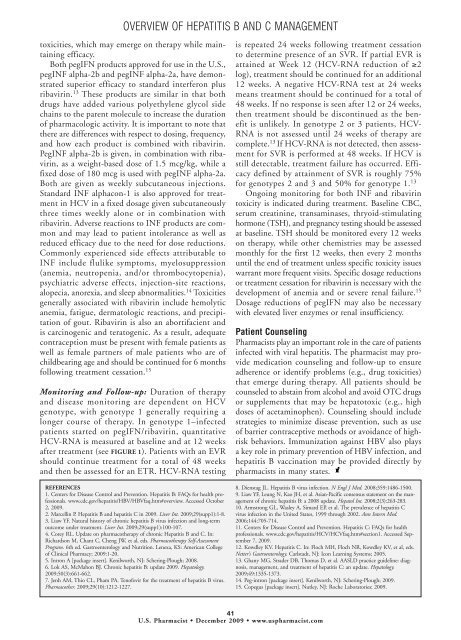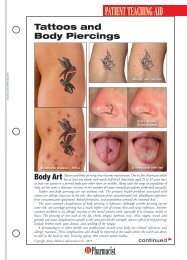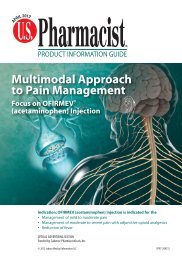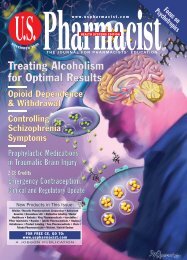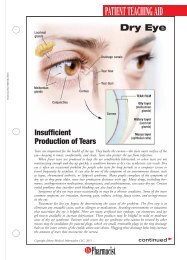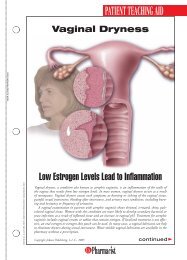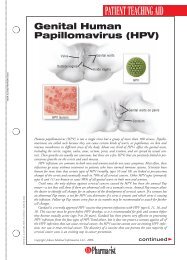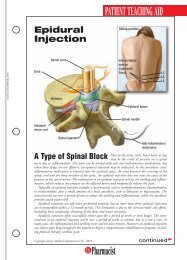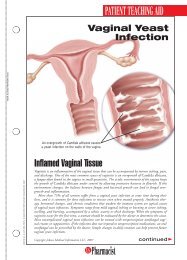View PDF Edition - U.S. Pharmacist
View PDF Edition - U.S. Pharmacist
View PDF Edition - U.S. Pharmacist
Create successful ePaper yourself
Turn your PDF publications into a flip-book with our unique Google optimized e-Paper software.
OVERVIEW OF HEPATITIS B AND C MANAGEMENT<br />
toxicities, which may emerge on therapy while maintaining<br />
efficacy.<br />
Both pegIFN products approved for use in the U.S.,<br />
pegINF alpha-2b and pegINF alpha-2a, have demonstrated<br />
superior efficacy to standard interferon plus<br />
ribavirin. 13 These products are similar in that both<br />
drugs have added various polyethylene glycol side<br />
chains to the parent molecule to increase the duration<br />
of pharmacologic activity. It is important to note that<br />
there are differences with respect to dosing, frequency,<br />
and how each product is combined with ribavirin.<br />
PegINF alpha-2b is given, in combination with ribavirin,<br />
as a weight-based dose of 1.5 mcg/kg, while a<br />
fixed dose of 180 mcg is used with pegINF alpha-2a.<br />
Both are given as weekly subcutaneous injections.<br />
Standard INF alphacon-1 is also approved for treatment<br />
in HCV in a fixed dosage given subcutaneously<br />
three times weekly alone or in combination with<br />
ribavirin. Adverse reactions to INF products are common<br />
and may lead to patient intolerance as well as<br />
reduced efficacy due to the need for dose reductions.<br />
Commonly experienced side effects attributable to<br />
INF include flulike symptoms, myelosuppression<br />
(anemia, neutropenia, and/or thrombocytopenia),<br />
psychiatric adverse effects, injection-site reactions,<br />
alopecia, anorexia, and sleep abnormalities. 14 Toxicities<br />
generally associated with ribavirin include hemolytic<br />
anemia, fatigue, dermatologic reactions, and precipitation<br />
of gout. Ribavirin is also an abortifacient and<br />
is carcinogenic and teratogenic. As a result, adequate<br />
contraception must be present with female patients as<br />
well as female partners of male patients who are of<br />
childbearing age and should be continued for 6 months<br />
following treatment cessation. 15<br />
Monitoring and Follow-up: Duration of therapy<br />
and disease monitoring are dependent on HCV<br />
genotype, with genotype 1 generally requiring a<br />
longer course of therapy. In genotype 1–infected<br />
patients started on pegIFN/ribavirin, quantitative<br />
HCV-RNA is measured at baseline and at 12 weeks<br />
after treatment (see FIGURE 1). Patients with an EVR<br />
should continue treatment for a total of 48 weeks<br />
and then be assessed for an ETR. HCV-RNA testing<br />
is repeated 24 weeks following treatment cessation<br />
to determine presence of an SVR. If partial EVR is<br />
attained at Week 12 (HCV-RNA reduction of ≥2<br />
log), treatment should be continued for an additional<br />
12 weeks. A negative HCV-RNA test at 24 weeks<br />
means treatment should be continued for a total of<br />
48 weeks. If no response is seen after 12 or 24 weeks,<br />
then treatment should be discontinued as the benefit<br />
is unlikely. In genotype 2 or 3 patients, HCV-<br />
RNA is not assessed until 24 weeks of therapy are<br />
complete. 13 If HCV-RNA is not detected, then assessment<br />
for SVR is performed at 48 weeks. If HCV is<br />
still detectable, treatment failure has occurred. Efficacy<br />
defined by attainment of SVR is roughly 75%<br />
for genotypes 2 and 3 and 50% for genotype 1. 13<br />
Ongoing monitoring for both INF and ribavirin<br />
toxicity is indicated during treatment. Baseline CBC,<br />
serum creatinine, transaminases, thryoid-stimulating<br />
hormone (TSH), and pregnancy testing should be assessed<br />
at baseline. TSH should be monitored every 12 weeks<br />
on therapy, while other chemistries may be assessed<br />
monthly for the first 12 weeks, then every 2 months<br />
until the end of treatment unless specific toxicity issues<br />
warrant more frequent visits. Specific dosage reductions<br />
or treatment cessation for ribavirin is necessary with the<br />
development of anemia and or severe renal failure. 15<br />
Dosage reductions of pegIFN may also be necessary<br />
with elevated liver enzymes or renal insufficiency.<br />
Patient Counseling<br />
<strong>Pharmacist</strong>s play an important role in the care of patients<br />
infected with viral hepatitis. The pharmacist may provide<br />
medication counseling and follow-up to ensure<br />
adherence or identify problems (e.g., drug toxicities)<br />
that emerge during therapy. All patients should be<br />
counseled to abstain from alcohol and avoid OTC drugs<br />
or supplements that may be hepatotoxic (e.g., high<br />
doses of acetaminophen). Counseling should include<br />
strategies to minimize disease prevention, such as use<br />
of barrier contraceptive methods or avoidance of highrisk<br />
behaviors. Immunization against HBV also plays<br />
a key role in primary prevention of HBV infection, and<br />
hepatitis B vaccination may be provided directly by<br />
pharmacists in many states.<br />
REFERENCES<br />
1. Centers for Disease Control and Prevention. Hepatitis B: FAQs for health professionals.<br />
www.cdc.gov/hepatitis/HBV/HBVfaq.htm#overview. Accessed October<br />
2, 2009.<br />
2. Marcellin P. Hepatitis B and hepatitis C in 2009. Liver Int. 2009;29(supp1):1-8.<br />
3. Liaw YF. Natural history of chronic hepatitis B virus infection and long-term<br />
outcome under treatment. Liver Int. 2009;29(supp1):100-107.<br />
4. Corey RL. Update on pharmacotherapy of chronic Hepatitis B and C. In:<br />
Richardson M, Chant C, Cheng JW, et al, eds. Pharmacotherapy Self-Assessment<br />
Program. 6th ed. Gastroenterology and Nutrition. Lenexa, KS: American College<br />
of Clinical Pharmacy; 2009:1-20.<br />
5. Intron A [package insert]. Kenilworth, NJ: Schering-Plough; 2008.<br />
6. Lok AS, McMahon BJ. Chronic hepatitis B: update 2009. Hepatology.<br />
2009;50(3):661-662.<br />
7. Jenh AM, Thio CL, Pham PA. Tenofovir for the treatment of hepatitis B virus.<br />
Pharmacother. 2009;29(10):1212-1227.<br />
8. Dienstag JL. Hepatitis B virus infection. N Engl J Med. 2008;359:1486-1500.<br />
9. Liaw YF, Leung N, Kao JH, et al. Asian-Pacific consensus statement on the management<br />
of chronic hepatitis B: a 2008 update. Hepatol Int. 2008;2(3):263-283.<br />
10. Armstrong GL, Wasley A, Simard EP, et al. The prevalence of hepatitis C<br />
virus infection in the United States, 1999 through 2002. Ann Intern Med.<br />
2006;144:705-714.<br />
11. Centers for Disease Control and Prevention. Hepatitis C: FAQs for health<br />
professionals. www.cdc.gov/hepatitis/HCV/HCVfaq.htm#section1. Accessed September<br />
7, 2009.<br />
12. Kowdley KV. Hepatitis C. In: Floch MH, Floch NR, Kowdley KV, et al, eds.<br />
Netter’s Gastroenterology. Carlstadt, NJ: Icon Learning Systems; 2005.<br />
13. Ghany MG, Strader DB, Thomas D, et al. AASLD practice guideline: diagnosis,<br />
management, and treatment of hepatitis C: an update. Hepatology.<br />
2009;49:1335-1373.<br />
14. Peg-intron [package insert]. Kenilworth, NJ: Schering-Plough; 2009.<br />
15. Copegus [package insert]. Nutley, NJ: Roche Laboratories; 2009.<br />
41<br />
U.S. <strong>Pharmacist</strong> • December 2009 • www.uspharmacist.com


